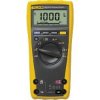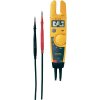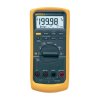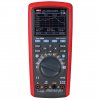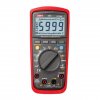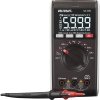
Todos hemos experimentado situaciones en las que un producto de calidad nos ha ahorrado una gran cantidad de tiempo y energía, ya se trate de un destornillador ordinario, una llave inglesa, unos alicates de calidad o un dispositivo de medición.
La empresa americana FLUKE, fabricante de multímetros de gran renombre especialmente entre profesionales, se centra en ofrecer una alta calidad.
¿Cómo se reconoce un multímetro de calidad? Debe cumplir con los criterios siguientes:
- Clase de seguridad - Por lo menos CAT III/600V, a ser posible, CAT III/1000V o, aún mejor, CAT IV/600V.
Incluso si se efectúan mediciones con una tensión relativamente baja de 230-240 V CA, nunca se sabe cuándo se producirá una sobretensión. Por eso un dispositivo de medición de calidad debe cumplir, como mínimo, con la clase de seguridad CAT III/600V, por supuesto, en función del equipo y del entorno en el que se efectúen las mediciones.
Sin embargo, por norma general, cuanto más exigente sea el entorno de medición, mayor será la clase de seguridad necesaria.
- Calidad de los cables de prueba: a primera vista, parece un parámetro innecesario y de difícil acceso.
Sin embargo, los cables de los instrumentos profesionales de marcas de prestigio están fabricados con materiales muy resistentes, con un núcleo muy flexible y puntas de medición ergonómicas que evitan el peligro del contacto no deseado con las partes bajo tensión.
- Diseño interno pensado para la fiabilidad y la seguridad, por ejemplo, con fusibles adecuadamente dimensionados y alta capacidad de corte.
- Resistencia del dispositivo a los daños eléctricos, p. ej., si se seleccionan cantidades o rangos de medida erróneos. Por desgracia, la importancia de este parámetro no se revela hasta que es demasiado tarde. Sin embargo, en la práctica, las marcas líderes suelen prestar atención también a este tipo de resistencia.
- Velocidad de medición o número de mediciones por segundo. Por lo general, es de 3-5 mediciones/s, lo habitual en dispositivos especializados con una frecuencia de medición relativamente alta. Una característica útil es el diagrama de barras lineal, que debe ser lo bastante ágil para informar al usuario de forma fiable sobre cambios rápidos en la cantidad medida, p. ej., al medir tensiones o corrientes inestables.
- Precisión de medición, uno de los parámetros básicos, que en la mayoría de los instrumentos de medición de rangos de tensión CC está entre el 1 % y el 0,1 %. Los dispositivos precisos de calibración de uso en laboratorio alcanzan una precisión aún mayor, p. ej., del 0,01 %.
- TRMS (TrueRMS): valor efectivo real de tensión o corriente CA. Característica de gran utilidad que mejora notablemente la precisión de las mediciones de tensión o corriente cuando estas no presentan una trayectoria sinusoidal precisa. En la práctica, esto sucede con frecuencia con las fuentes de alimentación conmutadas y similares.
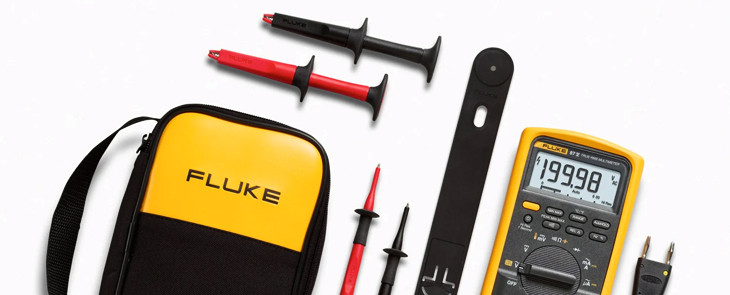
- Resistencia a la caída: siempre de gran utilidad, ya que nadie está a salvo de cometer errores. Muchos dispositivos profesionales cuentan con una resistencia garantizada a caídas desde una determinada altura, p. ej., 2 m.
- Conectividad USB. En la actualidad ya es bastante habitual que un multímetro pueda conectarse a un ordenador mediante una interfaz USB/RS232 para transmitir los datos medidos. En muchos casos, esto permite realizar mediciones automatizadas, p. ej., a intervalos de tiempo seleccionados.
- Capacidad de trabajar incluso en entornos con interferencias: en entornos industriales con equipos y motores que consumen grandes cantidades de energía (p. ej., convertidores de frecuencia, etc.), los multímetros baratos muestran valores aleatorios debido a las corrientes inducidas.
- Consumo del propio dispositivo en funcionamiento normal, es decir: la vida útil de la batería, es otro parámetro que no suele estar disponible para el usuario. En este caso, los dispositivos de calidad también ofrecen una ventaja, ya que suelen estar diseñados para consumir lo menos posible.
- Resistencia al agua y al polvo, esencial cuando se usan instrumentos de medida en entornos industriales exigentes.
- Ergonomía y manejo intuitivo en general: solo se puede trabajar bien con un dispositivo y aprovechar todas sus funciones si el manejo es comprensible. Para esto, unas buenas instrucciones son fundamentales.
Dispositivos de medición de alta calidad de FLUKE
Los multímetros FLUKE 287 y FLUKE 289 son excelentes ejemplos de dispositivos profesionales de medición del fabricante FLUKE.
Los rangos de medición que abarcan estos multímetros permiten medir condensadores de hasta 100 mF, algo poco común entre otros fabricantes. Estos multímetros permiten visualizar hasta 4,5 dígitos (lectura máxima: 50 000) y ofrecen una alta precisión de medición de hasta 0,025 % para tensión CC y 0,05 % para intensidad.
Por supuesto, ofrecen también mediciones de tensión (hasta 1000 V), intensidad (hasta 10 A), temperatura, resistencia y cortocircuito. Estos dispositivos de medición son aptos para registro de datos, ya que son capaces de registrar la evolución de las distintas magnitudes y visualizarla por medio de gráficos.

Además de características básicas como el diseño ergonómico, el display retroiluminado, el diagrama de barras analógico, el TRMS o el manejo con una sola mano (serie 110), ofrecen muchas de las ventajas de los multímetros de calidad descritos anteriormente.
Los folletos, con excelente información general, lo ayudarán a familiarizarse rápidamente con la gama de multímetros de FLUKE (en inglés):
Otros multímetros de alta calidad
Más allá de la marca FLUKE, encontrará multímetros de calidad para usos menos exigentes en los surtidos de las marcas Uni-Trend, Voltcraft y FLIR. Sin embargo, un multímetro de máxima calidad puede aumentar la eficiencia de su trabajo en todos los aspectos. Encontrará más información, p. ej., en nuestro artículo sobre este tema.
¿Estás interesado en más información? ¿O tiene alguna otra pregunta o consulta? Si es así, rellene el siguiente formulario y estaremos encantados de ayudarlo.
¿Le gustan nuestros artículos? ¡No se pierda ninguno! No tiene que preocuparse de nada; nosotros dispondremos el envío por usted.



















